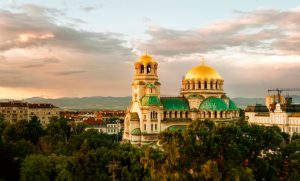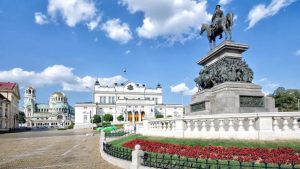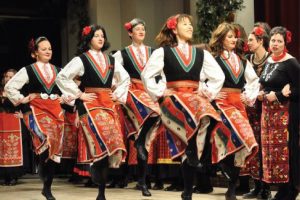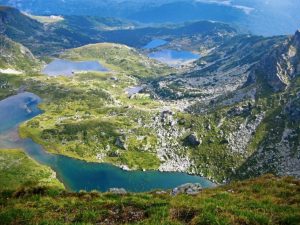Tourism in Bulgaria
Tourism in Bulgaria
Tourist places in Bulgaria
General information about Bulgaria

A country located in southeastern Europe bordering the Black Sea on its western side. It is bordered by Romania to the north, Turkey and Greece to the south, and the Republic of Serbia and Montenegro and the Republic of Macedonia to the west. With an area of 110,994 square meters.
Bulgaria occupies part of the eastern Balkan peninsula, bordering five countries, Greece and Turkey to the south, Macedonia and Serbia to the west, and Romania to the north.
The land border has a total length of 1,808 km (1,123 mi), and the coast is 354 km (220 mi). It has a total area of 110,994 square kilometers (42,855 square miles), ranked it as the 105th world – the abyss of the country. The geographical coordinates of Bulgaria are 43 ° N 25 ° E. [9]
The most notable topographical features are the Danube Plain and the Balkan Mountains, the Thracian Plain, and the Rhodope Mountains. On the southern edge of the Danube Plain slopes up to the foothills of the Balkan Mountains, while the Danube delineates the border with Romania. The Thracian Plain is almost triangular, starting from southeast Sofia and extending its reach to the Black Sea coast.
Culture and history
Traditional Bulgarian culture contains mainly Thracian, Slavic and Bulgarian heritage, along with Greek, Roman, Ottoman, Persian and Celtic a.
Bulgarian folk dances and musicians in traditional dress.
Bulgarian folk music is by far the most comprehensive traditional art, and it has developed slowly over the ages as a mixture of eastern and western influences. It contains the Far Eastern, Eastern, Medieval, Eastern Orthodox, standard, tonal, and Western European modes. The music has a distinctive sound and it uses a wide range of traditional instruments, such as a table, a ghida (bagpipe), a lock and a wan. One of the most distinctive features of stretching time is balanced, which has no parallel in the rest of European music. He won a Grammy Award in 1990. The written music composition in Bulgaria can be traced back to the early Middle Ages and the works of Ya Kokuzel (c. 1280-1360). . Bulgarian performances have gained popularity in many other genres such as progressive rock (FSB), electropop (Mira Arroyo) and jazz (Maalach Yifiv).
Sophia
It is the capital of the Balkan state in Bulgaria. It is located in the west of the country, under Vitosha Mountain. The city’s landmarks reflect more than 2,000 years of history, including the Greek, Roman, Ottoman and Soviet occupations. The Medieval Boyana Church has frescoes from the 13th century. The Church of St. George Rotunda by the Romans in the 4th century, features medieval décor and a estate dating back to the 10th century.

The Alexander Nevsky Cathedral in Sofia, with its bulbous dome and considered a national symbol, commemorates the Russian soldiers who were killed during the Russo-Turkish War in the 19th century. The floor of Saint Sophia’s Church was covered in early Christian mosaics. National Archaeological Museum (former mosque) houses a Thracian burial mask. The 19th-century Vrana Palace now houses museums of fine arts and ethnology. The huge 20th-century National Palace of Culture also organizes annual concerts and film festival. On Vitosha Mountain, Vitosha Nature Park is popular for hiking, mountain biking, summer stays in cottages and chalets, and skiing in the winter.
Plovdiv
It is an ancient city built around 7 hills, in southern Bulgaria. The regional archeology museum chronicles the history of the city, with exhibits including mosaic panels, pottery lamps, and early coins. The ancient theater in Phillips in the Roman era, in which about 6000 people sat, welcomes operas and concerts. A 3D movie in the old Emperor Hadrian’s stadium recreates Plovdiv in the 2nd century AD.
The old town includes buildings dating back to the 19th century, built in a distinctive style, with symmetrical designs and luxurious facades. Among them, the contemporary Balabanov House shows Bulgarian Art Nouveau contemporary. The Georgiadi House contains the Bulgarian National Revival Museum. The Regional Ethnographic Museum, with exhibits ranging from musical instruments and instruments, is occupied by Kuyumdzhiouglu House. Frescoes adorn the interior of the nine-domed mosque of Djumaya, which was rebuilt in the 15th century. Lake with Singing Fountains, which is the center of Tsar Simeon Park, features fountain shows with light and music effects.

Varna
It is a coastal city and seaside resort in the Black Sea in Bulgaria, next to the coastal resorts of Golden Sands, Saint Constantine and Albena. This city is famous for its “Varna gold,” a 6000-year-old Thracian jewelry discovered in a tomb, displayed inside the Archaeological Museum, along with Greek, Roman and Ottoman antiquities. There is a walkway facing the waterfront on the front end of the 19th-century village of Primorski Park.

Attractions at Primorski Park include Municipal Beach, Varna Aquarium, and performances at the Festa Dolphinarium. The nearby Maritime Museum contains the warship Drazky, famous for blowing up a Turkish cruiser in 1912. The central square is centered in Nezavisimost, in Varna’s historic district, and features Baroque, Art Deco and Neoclassical buildings as well as the Dormition of Theotokos, a Bulgarian Orthodox cathedral. A shrine with gilded copper domes, icons donated by Nicholas II of Russia. Varna Historical Museum also focuses ar

The historical development of the city, near the ruins of the Roman baths in the fourth century.
Rela
It is a mountain range in southwestern Bulgaria and the highest mountain range in Bulgaria and the Balkans, with its highest peak being Musala at an altitude of 2,925 meters. It is also the sixth highest mountain in Europe, after the Caucasus, the Alps, the Sierra Nevada, the Pyrenees and Mount Etna. More than a third of the mountain is occupied by Rila National Park, and the rest is located within the Rila Monaster Nature Park. The mountain is believed to have been named after the river of the same name, which comes from the old Bulgarian verb “рыти” which means “grub”. Rila is abundant in glacial lakes and hot springs in fault areas at the base of the mountain. Some of the longest and deepest rivers in the Balkans originate from Rila, including the Maritsa, Iscar and Mesta. Culturally, Rila is famous for the Rila Monastery, the largest and most important monastery in Bulgaria, which was founded by Saint John of Rila in the 10th century. Besides cultural attractions, the mountain is also famous for the Seven Rila Lakes.
